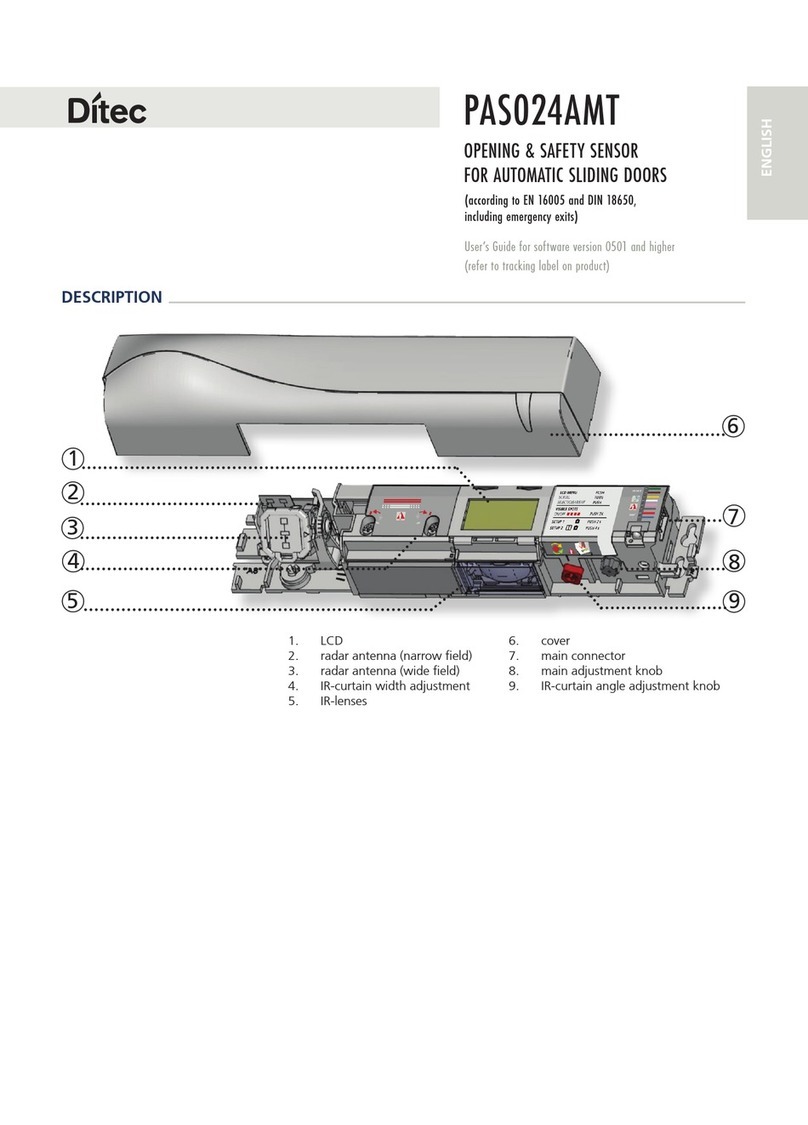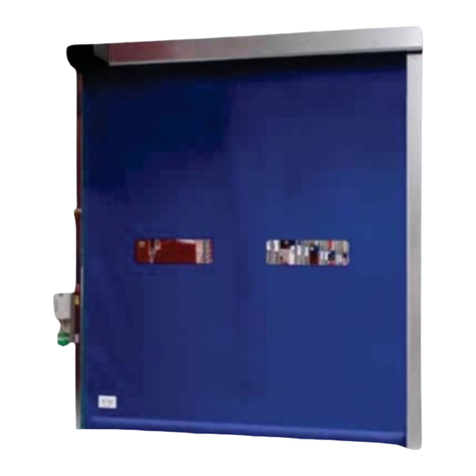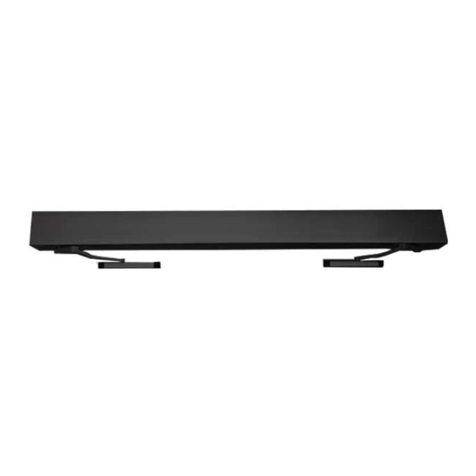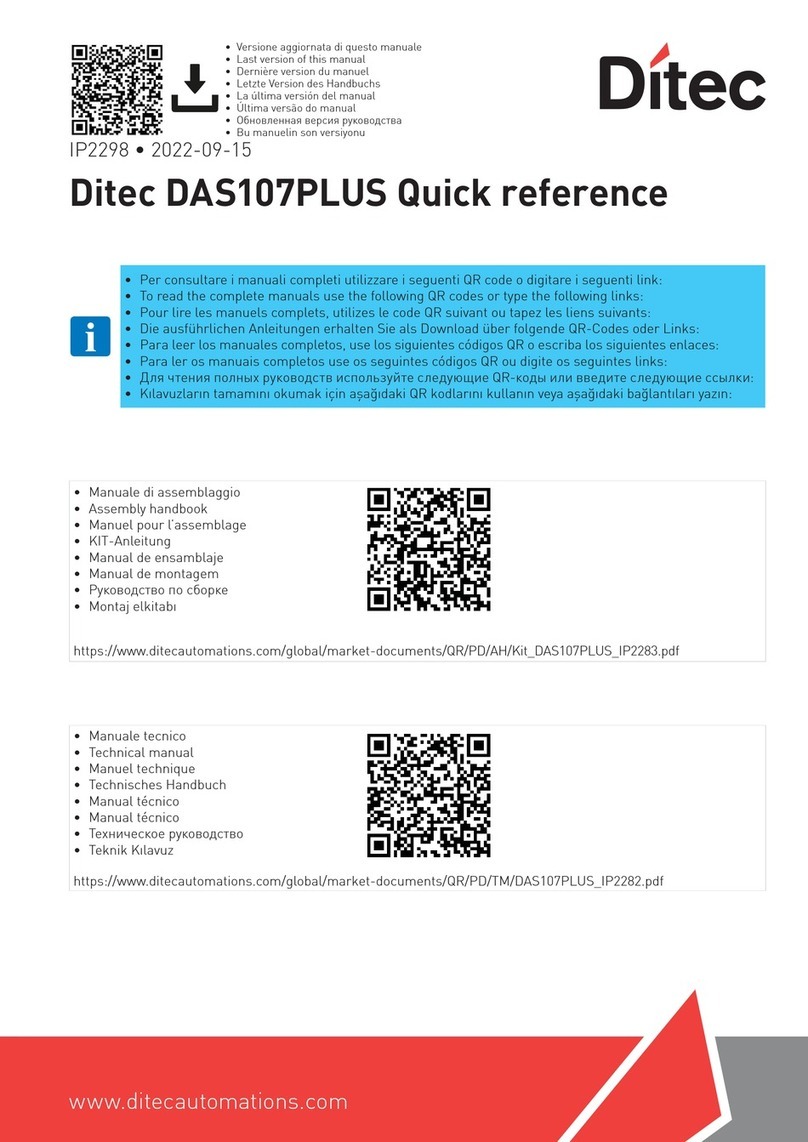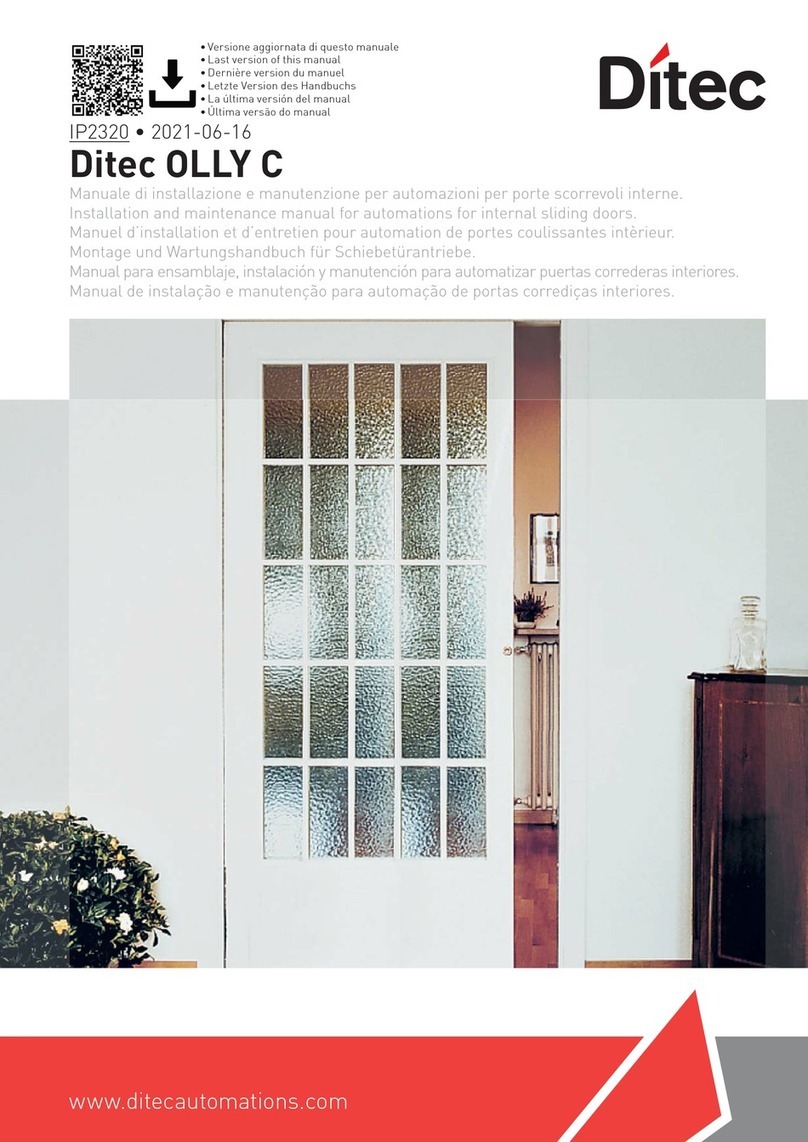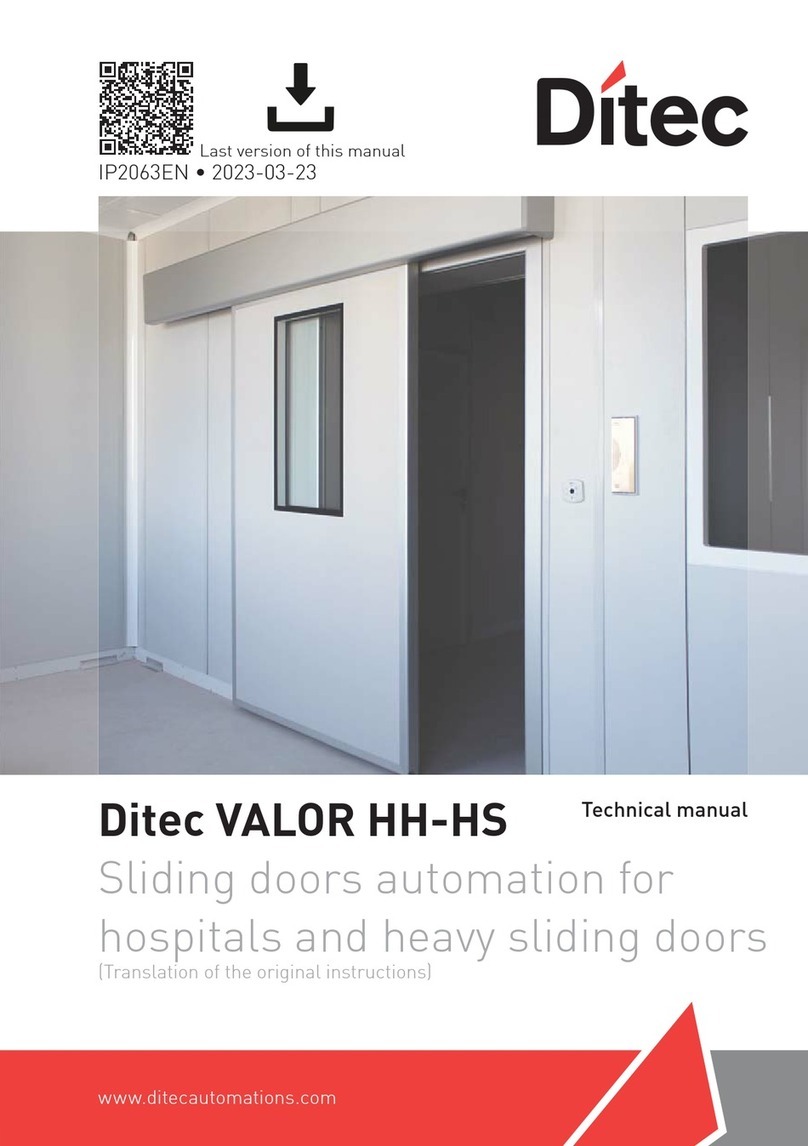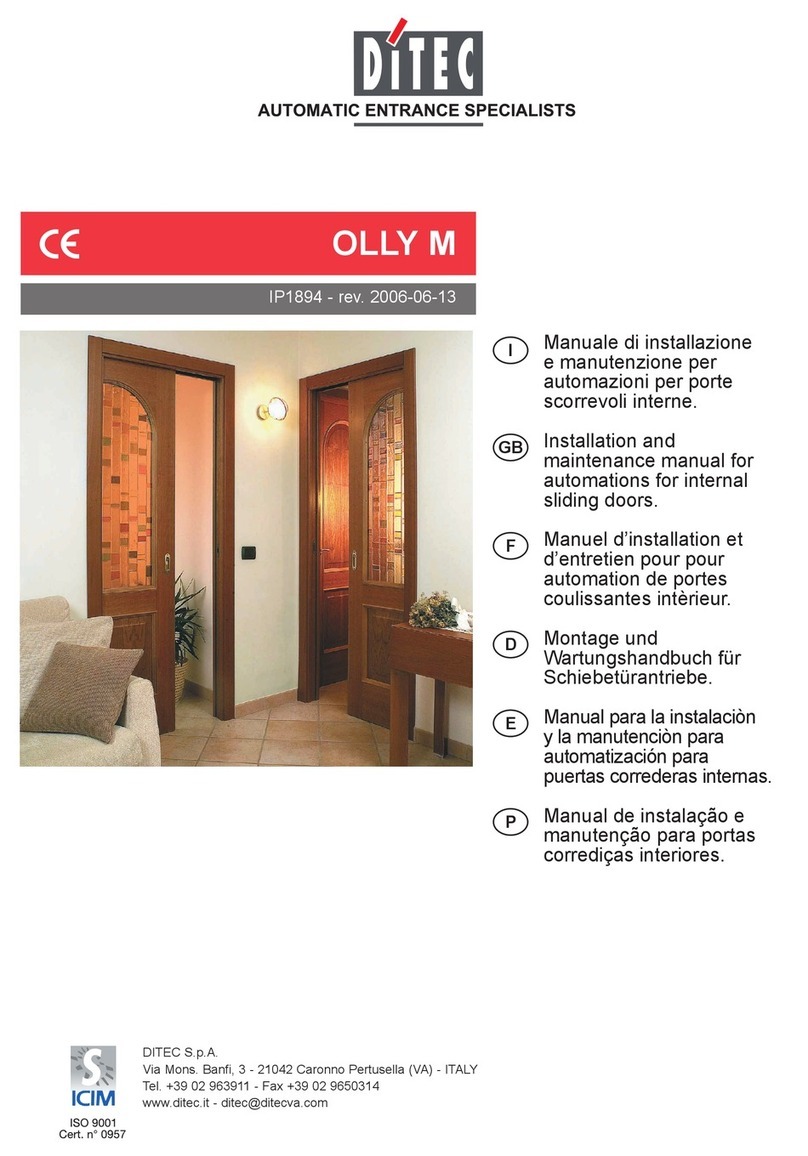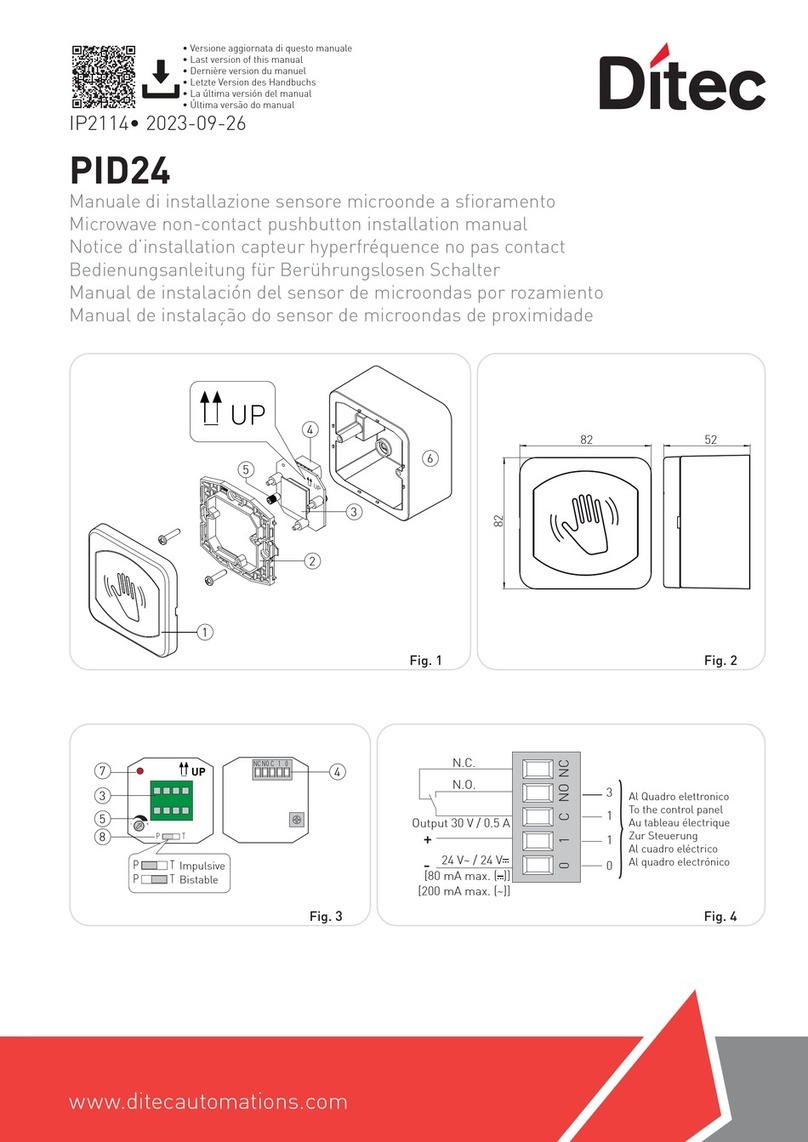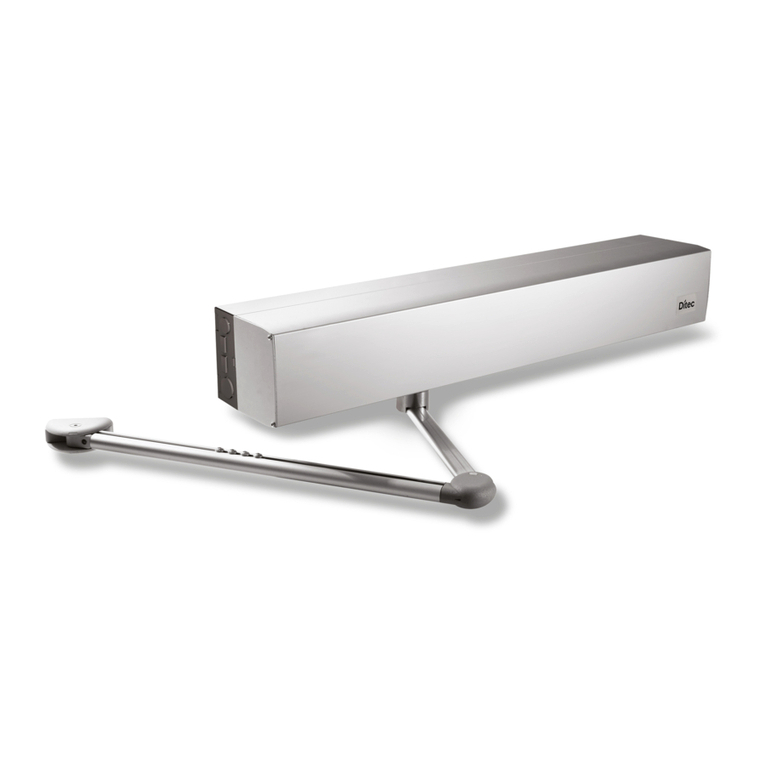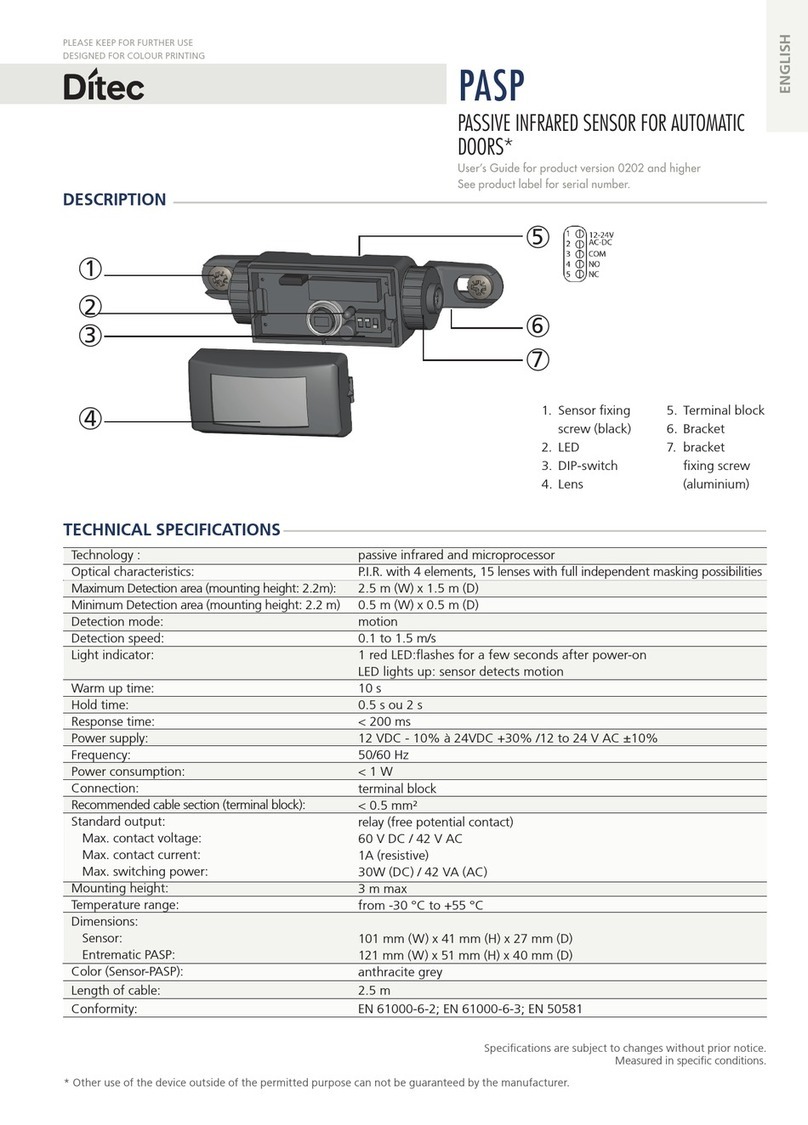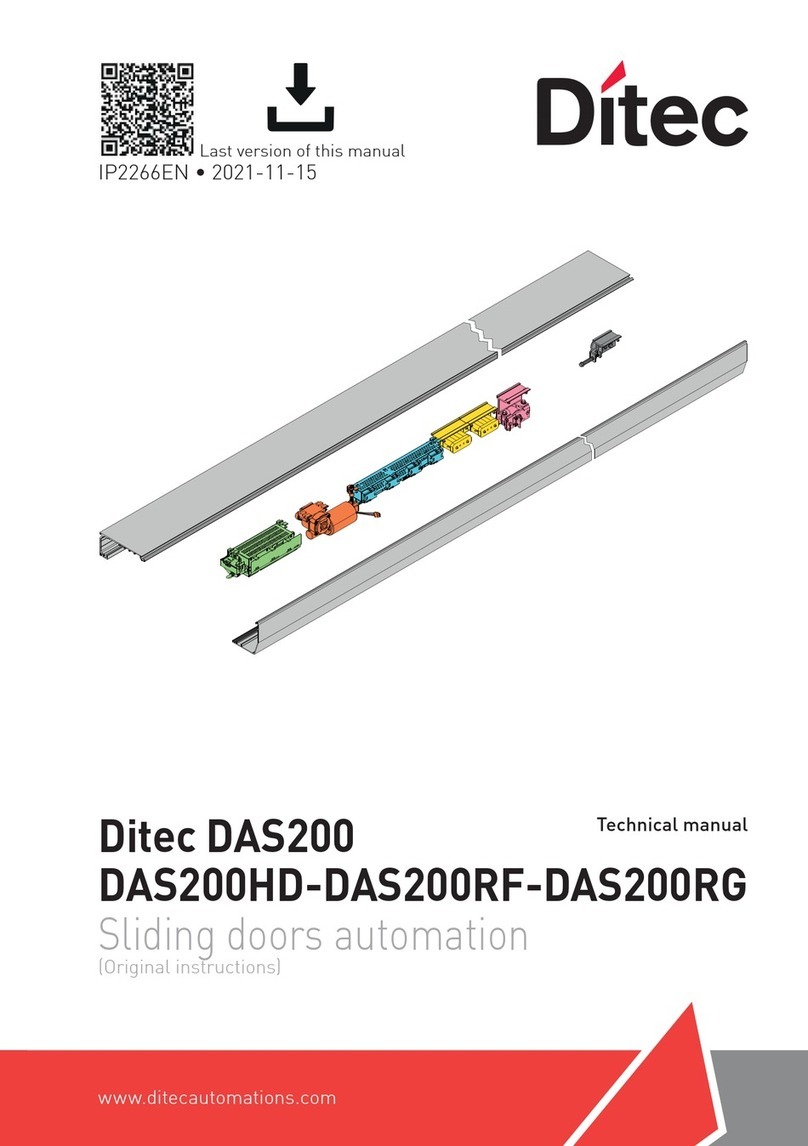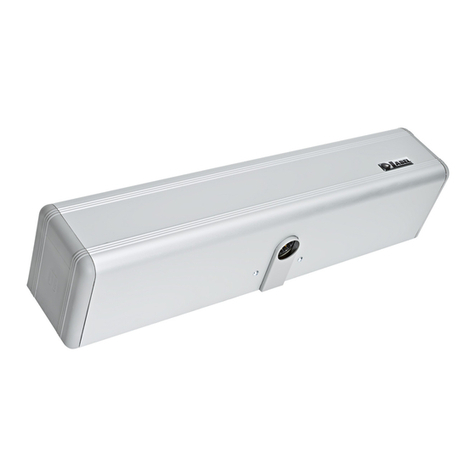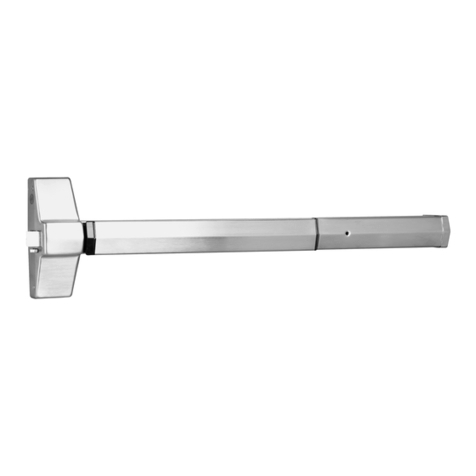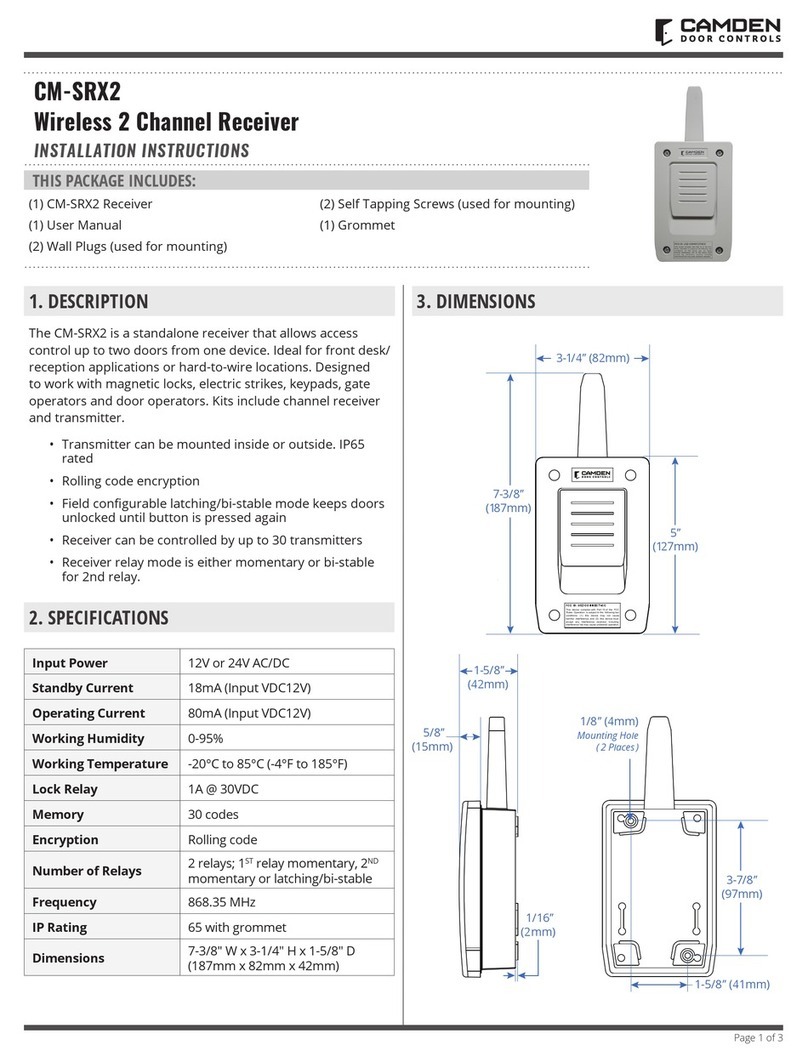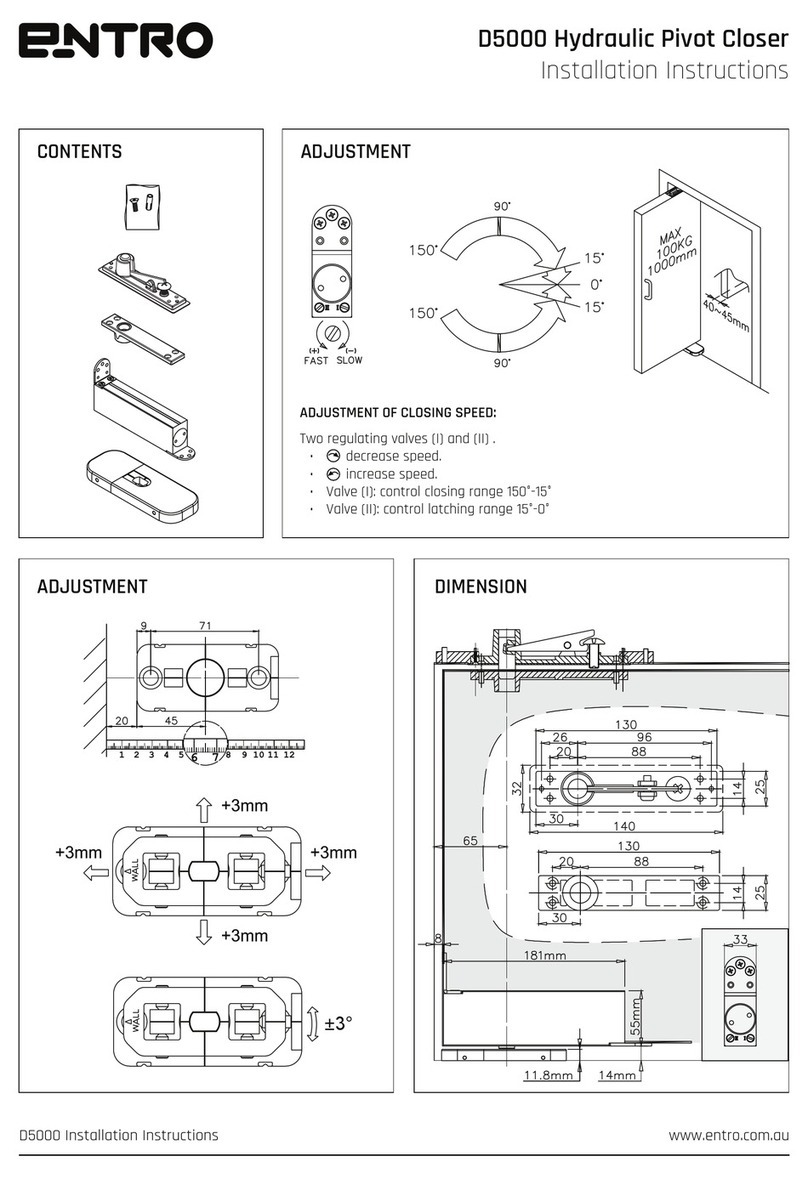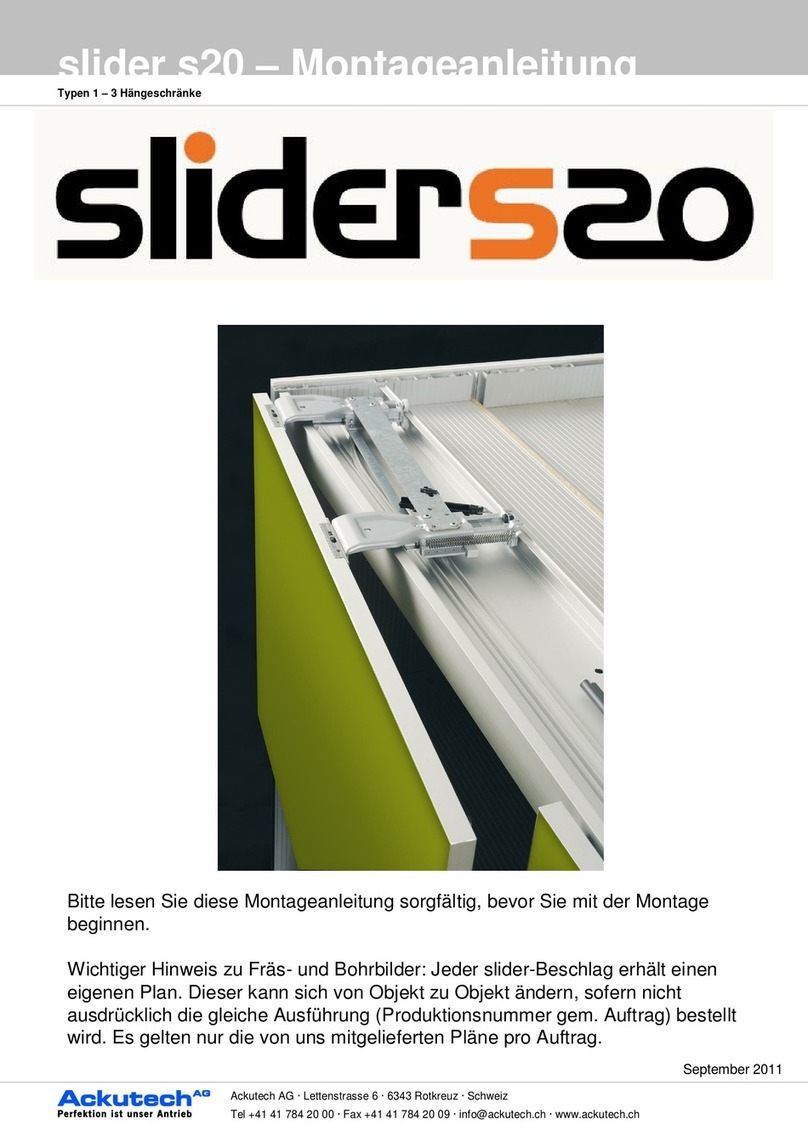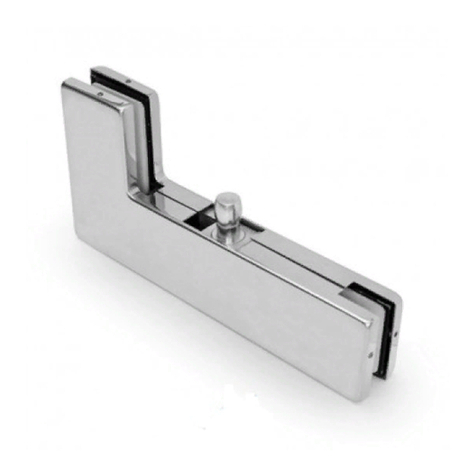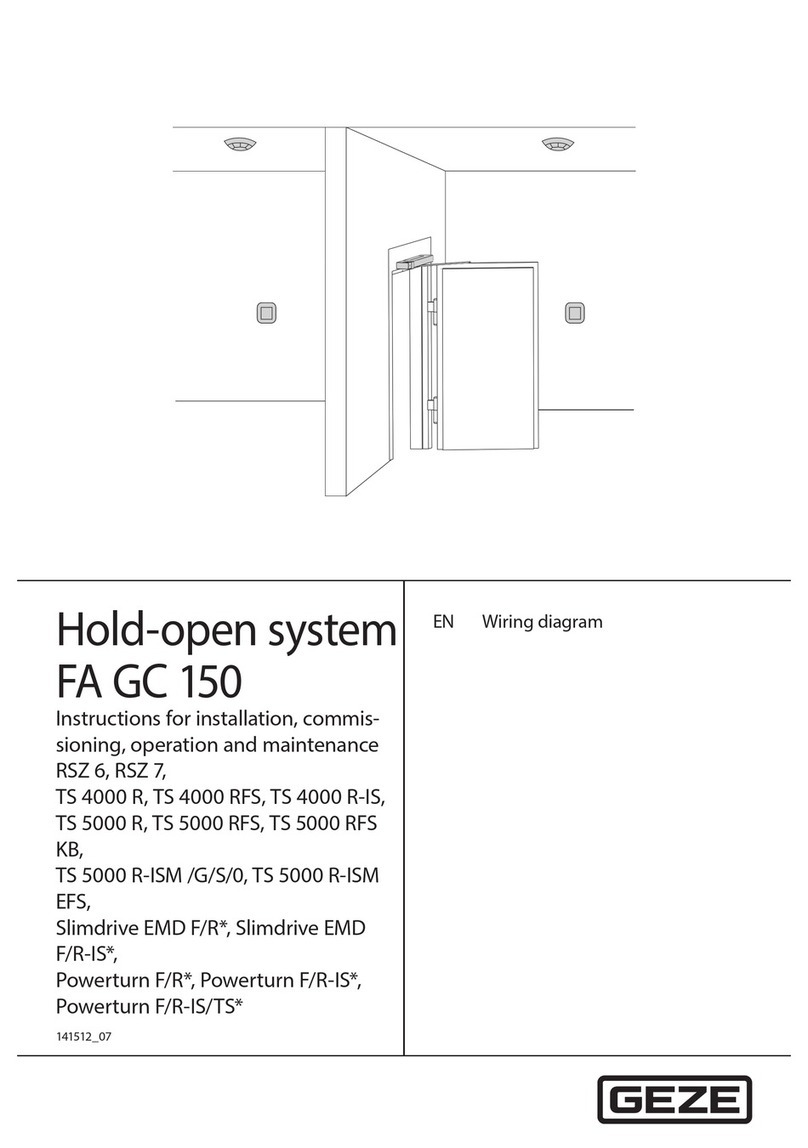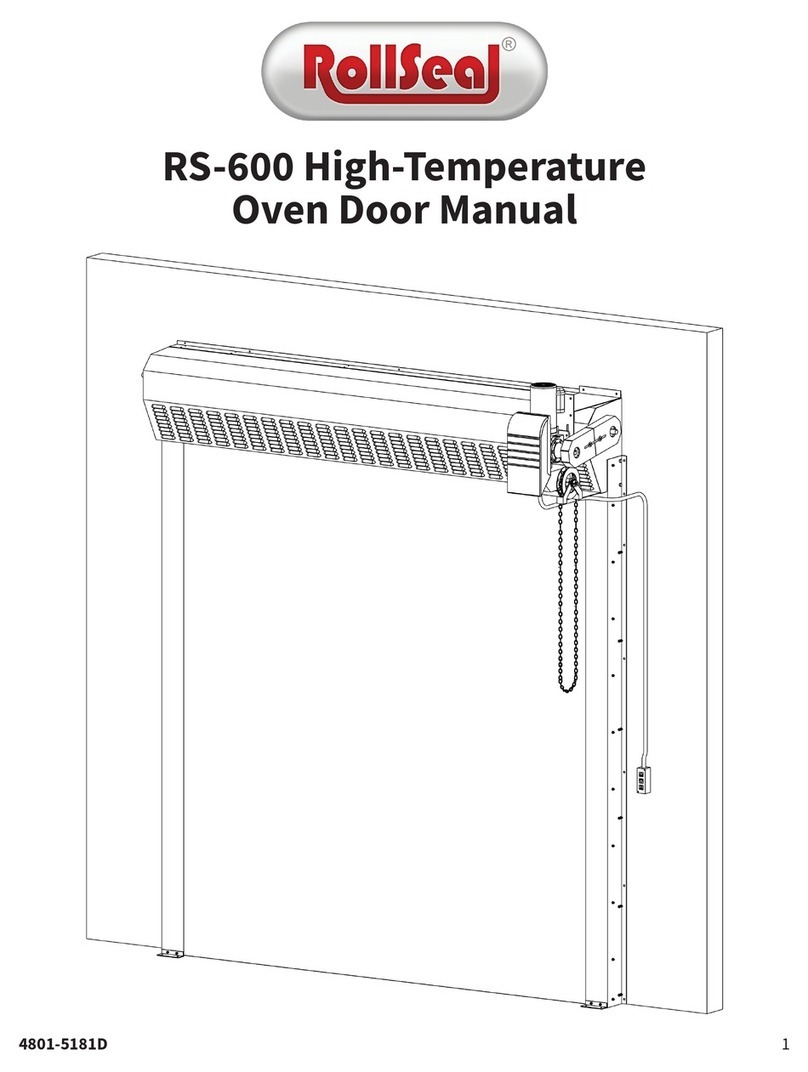DITEC VALOR User manual

Ditec VALOR
Sliding doors automation
(Original instructions)
IP1950 EN
Technical manual
www.ditecentrematic.com

2
IP1950EN - 2013-09-13
Index
Subject Page
1. General safety precautions 3
2. Declaration of incorporation of partly completed machinery 4
2.1 Machinery directive 4
3. Technical data 5
3.1 Applications 5
4. Standard installation 6
5. Installation of the automation 7
5.1 VALOR box fastening 7
5.2 VALOR T box fastening 8
5.3 VALOR H box fastening 9
5.4 Preparation of glass door wing 11
5.5 VALOR - VALOR H door wing installation and adjustment 12
5.6 VALOR T door wing installation and adjustment 13
5.7 Floor guide installation 15
5.8 Belt adjustment 16
5.9 Lock installation 16
6. Electrical connections 17
7. Ordinary maintenance program 18
User instructions 19
General safety precautions 19
Manual release instruction 21
Function selector user instructions 22
Key
This symbol indicates useful information for the correct functioning of the product.
This symbol indicates instructions or notes regarding safety, to which special atten-
tion must be paid.
i

3
IP1950EN - 2013-09-13
1. General safety precautions
This installation manual is intended for qualified personnel only.
Installation, electrical connections and adjustments must be performed in accordance with
Good Working Methods and in compliance with the present standards.
Read the instructions carefully before installing the product.
Bad installation could be dangerous.
The packaging materials (plastic, polystyrene, etc.) should not be discarded in the environ-
ment or left within reach of children, as these are a potential source of danger.
Before installing the product, make sure it is in perfect condition.
Do not install the product in explosive areas and atmospheres: the presence of inflammable
gas or fumes represents a serious safety hazard.
Before installing the motorisation device, make all the necessary structural modifications in
order to create safety clearance and to guard or isolate all the crushing, shearing, trapping
and general hazardous areas.
Make sure the existing structure is up to standard in terms of strength and stability. The mo-
torisation device manufacturer is not responsible for failure to observe Good Working Methods
when building the frames to be motorised or for any deformation during use.
The safety devices (photocells, safety edges, emergency stops, etc.) must be installed
taking into account: applicable laws and directives, Good Working Methods, installation
premises, system operating logic and the forces developed by the motorised door.
The safety devices must protect the crushing, cutting, trapping and general hazardous areas
of the motorised door.
Display the signs required by law to identify hazardous areas.
Each installation must bear a visible indication of the data identifying the motorised door.
When requested, connect the motorised door to an effective earthing system that complies
with current safety standards.
During installation, maintenance and repair operations, cut off the power supply before opening
the cover to access the electrical parts.
The automation protection casing must be removed by qualified personnel only.
The electronic parts must be handled using earthed antistatic conductive arms.
The manufacturer of the motorisation declines all responsibility in the event of component
parts being fitted that are not compatible with the safe and correct operation.
Use original spare parts only for repairs or replacements of products.
The installer must supply all information on automatic, manual and emergency operation of the
motorised door and must provide the user with the operating instructions.
Failure to observe the information in this manual may result
in minor personal injury or damage to equipment.
Save these instructions for future reference.

4
IP1950EN - 2013-09-13
2. Declaration of incorporation of partly com-
pleted machinery
2.1 Machinery Directive
(Directive 2006/42/EC, Annex II-B)
The manufacturer Entrematic Group AB with headquarters in Lodjursgatan 10, SE-261 44
Landskrona, Sweden
declares that the automation system for Ditec VALOR sliding doors:
- has been constructed to be installed on a manual door to construct a machine pursu-
ant to the Directive 2006/42/EC. The manufacturer of the motorized door shall declare
conformity pursuant to the Directive 2006/42/EC (annex II-A), prior to the machine being
put into service;
- conforms to applicable essential safety requirements indicated in annex I, chapter 1 of
the Directive 2006/42/EC;
- conforms to the Low Voltage Directive 2006/95/EC;
- conforms to the Electromagnetic Compatibility Directive 2004/108/EC;
- technical documentation conforms to Annex VII-B to the Directive 2006/42/EC;
- technical documentation is managed by Marco Pietro Zini with offices in Via Mons. Banfi,
3 - 21042 Caronno Pertusella (VA) - ITALY;
- a copy of technical documentation will be provided to national competent authorities,
following a suitably justified request.
Landskrona, 15-01-2013 Marco Pietro Zini
(President)
Pursuant to Machinery Directive (2006/42/EC) the installer who motorizes a door or gate has
the same obligations as the manufacturer of machinery and as such must:
- prepare the technical file which must contain the documents indicated in Annex V of the
Machinery Directive;
(The technical file must be kept and placed at the disposal of competent national authori-
ties for at least ten years from the date of manufacture of the motorized door);
- draw up the EC Declaration of Conformity in accordance with Annex II-A of the Machinery
Directive and deliver it to the customer;
- affix the EC marking on the motorized door in accordance with point 1.7.3 of Annex I of
the Machinery Directive.

5
IP1950EN - 2013-09-13
Service class: 5 (minimum 5 years of working life with 600 cycles per day).
Applications: VERY INTENSE (for shared entrances with very intense pedestrian use).
Service class: 6 (minimum 5 years of working life with continuous use).
Applications: CONTINUOUS (for all special situations with continuous use).
- Performance characteristics are to be understood as referring to the recommended weight
(approx. 2/3 of maximum permissible weight). A reduction in performance is to be expected
when the access is made to operate at the maximum permissible weight.
- Service class, running times, and the number of consecutive cycles are to be taken as merely
indicative having been statistically determined under average operating conditions, and are
therefore not necessarily applicable to specific conditions of use. During given time spans
product performance characteristics will be such as not to require any special maintenance.
- The actual performance characteristics of each automatic access may be affected by independ-
ent variables such as friction, balancing and environmental factors, all of which may substan-
tially alter the performance characteristics of the automatic access or curtail its working life
or parts thereof (including the automatic devices themselves). When setting up, specific local
conditions must be duly borne in mind and the installation adapted accordingly for ensuring
maximum durability and trouble-free operation.
3. Technical data
Ditec VALOR L-H Ditec VALOR P Ditec VALOR N Ditec VALOR T
Power supply 230 V~ 50/60 Hz 230 V~ 50/60 Hz 230 V~ 50/60 Hz 230 V~ 50/60 Hz
Power fuse F1A
F1A
F1,6A with weight
>200 kg
F1A
F1,6A with weight
>200 kg
F1A
F1,6 A with weight
>200 kg
Rated power input 200 W 300 W 300 W 300 W
Max speed 1 wing 0,8 m/s 0,8 m/s 0,8 m/s -
Max speed 2 wings
1,6 m/s
1,6 m/s
1,2 m/s with
weight 180 kg
1,6 m/s
1,2 m/s with
weight 180 kg
0,8 m/s
Max speed 4 wings ---1,6 m/s
Service life 5 - HEAVY DUTY 6 - CONTINUOUS 6 - CONTINUOUS 6 - CONTINUOUS
Intermittence S3=100% S3=100% S3=100% S3=100%
Max door weight 1 wing
100 kg
120 kg
100 kg 1 break-
out door wing
120 kg 200 kg
Max door weight 2 wings
180 kg
220 kg
180 kg 2 break-
out door wings
240 kg 260 kg
Door weight with reinfor-
ced wheels 1 wing --150 kg -
Door weight with reinfor-
ced wheels 2 wings --300 kg -
Temperature -20 °C - +55 °C -20 °C - +55 °C -20 °C - +55 °C -20 °C - +55 °C
Temperature with
batteries -10 °C - +50 °C -10 °C - +50 °C -10 °C - +50 °C -10 °C - +50 °C
Degree of protection IP20
(FOR INTERNAL
USE ONLY)
IP20
(FOR INTERNAL
USE ONLY)
IP20
(FOR INTERNAL
USE ONLY)
IP20
(FOR INTERNAL
USE ONLY)
Control panel EL20 EL20 EL20 EL20
Accessories power
supply 24 V 0,5 A 24 V 0,5 A 24 V 0,5 A 24 V 0,5 A
3.1 Operating instructions

6
IP1950EN - 2013-09-13
4. Standard installation
Ref. Code Description
0VALOR Operator
1Drive unit
2EL20 Control panel
3AL2 Transformer
4VALABE
VALABC
Emergency batteries (optional)
No-break batteries (optional)
5 PAS024AMW (microwave+infrared), or
PASAA2 (only infrared)
Combined sensor for opening and safety during closing
external side
6A PAS024AMW (microwave+infrared), or
PASAA2 (infrared only)
Combined sensor for opening and safety during closing
internal side (operator)
or
6B
PASM24W (microwave), or
PASM243 (microwave), or
PASS24 (microwave), or
PASS24W (microwave), or
PASA (infrared) }+ PASAT3I
(infrared)
Opening sensor (a) + Safety during closing sensor (b) inter-
nal side (inside the operator’s housing)
7PASAT3
PASAT3I
Safety during opening sensor (outside or inside the opera-
tor’s housing)
8VALSB
LOKSBM
Integrated release handle
Release handle
9COME - COMHK Functions selector switch
10 CELPR Photocells (NOT ACCORDING TO STANDARD EN 16005)
11 MD1 Display
12 PFP1 - PFP2 - PDP1 - PDP2 Open push buttons
AConnect the power supply to an approved omnipolar switch with an opening distance of the contacts of at least
3mm (not supplied). The connection to the mains must be made via an independent channel, separated from
the connections to command and safety devices.
A
11
3
1
2
4
6A
6B
7
0
8
9
10
12
7
GND
5
a
b
6B

7
IP1950EN - 2013-09-13
i
The given operating and performance features can only be guaranteed with the use of
DITEC accessories and safety devices.
5. Installation of the automation
5.1 VALOR box fastening
70 max
0KP515AB
+/- 8
+/- 6
175
80
90
38
2728H
10 HM = H + 18
145
Unless otherwise specified, all measurements are expressed in millimetres (mm).
The VALOR automation wall fixing measurements are illustrated in the diagram, considering that
the door wing profiles are not of our production.
If the door wings are made with DITEC profiles of the PAM series: refer to the measurements in
the related manuals.
WARNING: if the door wings are fitted with a break-out device, use the carriages with brackets
with 3 fixing points.
Fix the box with M6 Ø12 steel plugs or 6MA screws. Distribute the fixing points approx. every 800
mm.
Make sure that the box is level and its top surface is perpendicular with the floor and not deformed
lengthwise with the shape of the wall. If the wall is not straight and smooth, the box must be fixed
to metal plates.
WARNING: The fastening of the box to the wall must be suitable in order to sustain the weight of
the door wings.
Wiring passage

8
IP1950EN - 2013-09-13
5.2 VALOR T box fastening
KPAM45
KPAM45
255
160
70 max 70 max
90
38
2728
H
12
145
+/- 8
HM=H+16
+/- 6 +/- 6
Unless otherwise specified, all measurements are expressed in millimetres (mm).
The figure shows the measurements for wall mounting the VALOR H automation considering that
the door wings are made of DITEC PAMH60 series profiles.
If the PAMH60 door wing has lead-shielding (e.g. radiology department) refer to the measure-
ments marked [*].
Fix the box with M6 Ø12 steel plugs or 6MA screws. Distribute the fixing points approx. every 800
mm.
Make sure that the box is level and its top surface is perpendicular with the floor and not deformed
lengthwise with the shape of the wall. If the wall is not straight and smooth, the box must be fixed
to metal plates.
WARNING: The fastening of the box to the wall must be suitable in order to sustain the weight of
the door wings.
Wiring passage

9
IP1950EN - 2013-09-13
5.3 VALOR H box fastening
Wiring passage
VALH60
PAMH60
170 ≥15
6010
HM=H-8
HM=H+60*
12
8*
H50
*114
90
38
175
PH=H-34 34
-8 +27
66

10
IP1950EN - 2013-09-13
max 600
min 80
PL=L-68
L
LM=L+46 (LM=L+164)*
57
116*
57
116*
74
34
10
10
39
30
Unless otherwise specified, all measurements are expressed in millimetres (mm).
The figure shows the measurements for wall mounting the VALOR H automation considering that
the door wings are made of DITEC PAMH60 series profiles.
If the PAMH60 door wing has lead-shielding (e.g. radiology department) refer to the measure-
ments marked [*].
Fix the box with M6 Ø12 steel plugs or 6MA screws. Distribute the fixing points approx. every 800
mm.
Make sure that the box is level and its top surface is perpendicular with the floor and not deformed
lengthwise with the shape of the wall. If the wall is not straight and smooth, the box must be fixed
to metal plates.
WARNING: The fastening of the box to the wall must be suitable in order to sustain the weight of
the door wings.

11
IP1950EN - 2013-09-13
Ø10 Ø10 Ø10
100
100100
100
L≤1000
L≤1000
11
11
100 100 100 100
L>1000
Ø15
Ø15
30 30
100100
3030
L≤1000
Ø15
L>1000
L>1000
100 100 100 100
100 100 100 100
10
12
Ø15 Ø15
Ø15
With AC4255 or AC4870 glass wing attachment applications, see the respective manual.
The diagram indicates the process measurements of the aluminium profile AC1356 and glass.
Ø10 through holes are required on the aluminium profile and Ø15 on the glass for fastening. The
number of holes and related distance between centres are based on the door wing width. Silicon
should ideally be used between the edge of the glass and the internal base of the profile.
5.4 Preparation of the glass door wing
i

12
IP1950EN - 2013-09-13
5.5 VALOR - VALOR H wings installation and adjustment
VALOR 2 WINGS
VALOR 1 WING - RIGHT OPENING
VALOR 1 WING - LEFT OPENING
Make sure that the central wheel [d] is adjusted as illustrated in the diagram.
Fix the door wing to the carriage with screws [a].
The outer wheel of the carriage must not protrude beyond the dimension of the door wing.
Adjust the horizontal position of the door wing in accordance with the measurements indicated in
diagram VALOR 2 for 2 door wing automations, VALOR 1 RH for right-hand opening automations
and VALOR 1 LH for left-hand opening automations. Secure the adjustment with screws [a].
Loosen screws [b], adjust the vertical position of the door wing by means of screw [c] and fix the
adjustment with screws [b].
Check, by moving the door manually, that the movement is free and without friction and that al
the wheels rest on the guide.
WARNING: Leave a gap of at least 10 mm between the glass door wings when closed to avoid
contact of the glass.
150200
LM
OPEN
200150
LM
OPEN
LM
150 150150 150
LM
OPEN OPEN
a
c d
b b
max 0,5 mm
d

13
IP1950EN - 2013-09-13
Make sure that the central wheel [d] is adjusted as illustrated in the diagram.
Fix the door wing to the carriage with screws [a].
The outer wheel of the carriage must not protrude beyond the dimension of the door wing.
Adjust the horizontal position of the door wing in accordance with the measurements indicated in
diagram VALOR 2 +2 for four door wing automations, VALOR 1 +1 RH for right-hand opening automa-
tions and VALOR 1 +1 LH for left-hand opening automations. Secure the adjustment with screws [a].
Loosen screws [b], adjust the vertical position of the door wing by means of screw [c] and fix the
adjustment with screws [b].
Check, by moving the door manually, that the movement is free and without friction and that al
the wheels rest on the guide.
Proceed as follows to adjust the overlap of the door wings:
- Place the door in the closed position.
- Hold the external door wing in the closed position.
- Loosen [g] and move the door wing, increasing or decreasing the overlap.
- Tighten [g].
Adjust the tension of the cables by means of adjuster [e], loosening the locking nut.
Correctly tension the cable, then block it with the locking nut.
a
c d
b b
e
f
e
g
f
max 0,5 mm
max 0,5 mm
5.6 VALOR T wings installation and adjustment
g
f
3 mm

14
IP1950EN - 2013-09-13
LM
200 150 100
S
150
LM
OPEN OPEN
LM
S
200
150
150 100
OPENOPEN
LM
de
f
d e f
LMLM
S
150 150
150
150 100
150 100 150
OPENOPEN OPEN OPEN
LM LM
S
d dee f f
VALOR 1+1 WING - RIGHT OPENING
VALOR 1+1 WING - LEFT OPENING
VALOR 2+2 WINGS

15
IP1950EN - 2013-09-13
The floor guides must be made of an antifriction material such as PVC, NYLON, TEFLON. The
length of the floor guide should not be greater than the overlap of between the fixed and mobile
door wing and must not enter the doorway.
The measurements of the code 0KP515AB floor guide for framed door wings are indicated in the
diagram.
min 21
max 40
10
22
10
HM
50
The measurements of the code KPAM45 floor guide for telescopic door wings are indicated in the diagram.
12
5
12
42 42
19
50
HM
The floor guide for the PAMH60 door wing has the measurements indicated in paragraph 5.3.
The measurements of the code 0KP369 floor guide for glass door wings are indicated in the diagram.
10 HVM
40
10-12
25
5
50
5.7 Floor guide installation

16
IP1950EN - 2013-09-13
5.8 Belt adjustment
5.9 Lock device installation
Loosen screws [a], unscrew screw [b] until the spring is at a compression of 22 mm (if the length
of the automation is lower than 2600 mm) or 20 mm (if the length of the automation is greater
than 2600 mm).
Block the adjustment by tightening screws [a].
WARNING: incorrect adjustment impairs the correct functioning of the automation.
Place the door wing in the closure position.
Fasten the lock device to the box profile by means of the supplied screws [a].
Align the lock pin [b] and the lock bracket [c] and manually check the correct functioning.
Slightly lubricate the lock pin and lock bracket.
LT<2600 = 22 mm
LT≥2600 = 20 mm
b
a
a
bc
a
bc

17
IP1950EN - 2013-09-13
Before connecting the power supply, make sure the plate data correspond to that of the
mains power supply.
An omnipolar disconnection switch with minimum contact gaps of 3 mm must be included in
the mains supply.
Check that upstream of the electrical installation there is an adequate residual current circuit
breaker and a suitable overcurrent cutout.
Use a H05RN-F 3G1,5 or H05RR-F 3G1,5 type electric cable and connect to the terminals L
(brown), N (blue), (yellow/green) in the automation. Make sure the yellow/green conductor
is at least 30 mm longer than the brown and blue conductors.
Secure the cable using the special cable clamp and remove the outer sheath near the terminal
only.
Connection to the mains power supply, in the section outside the automation, is made with
independent channels and separated from the connections to the control and safety devices.
The channels must penetrate a few centimetres inside the automation thorough a hole maxi-
mum Ø16 mm.
Make sure there are no sharp edges that may damage the power supply cable.
Make sure that the mains power supply (230 V) conductors and the accessory power supply
(24 V) conductors are separate.
Make sure the yellow/green conductor
is at least 30 mm longer than
the brown and blue conductors.
6. Electrical connections
Electrical wiring and starting are shown in the installation manual of control panel EL20.

18
IP1950EN - 2013-09-13
Perform the following operations and checks every 6 months according to intensity of use of
the automation.
Without 230 V~ power supply and batteries:
- Clean and lubricate the moving parts (the carriage guides and the floor guides).
- Check the belt tension.
- Clean sensors and photocells.
- Check the stability of the automatic system and make sure that all screws are correctly tight-
ened.
- Check the alignment of the doors, the closing positions and the correct introduction of the
blocking device.
Connect the 230 V~ power supply and batteries:
- Check that the blocking system is working correctly.
- Check the stability of the door and that the movement is regular and without friction.
- Check that all command functions are operating correctly.
- Check the correct functioning of the photocells.
- Check that the door’s developed powers are in accordance with applicable regulations.
7. Routine maintenance plan
NOTE: for spare parts, see the spares price list.
i
i
For repairs or replacements of products only original spare parts must be used.
The installer shall provide all information relating to automatic, manual and emergency
operation of the motorised door or gate, and provide the user with operating instructions.
The installer must prepare the maintenance log, which will indicate all the interven-
tions of ordinary and extraordinary maintenance carried out.

19
IP1950EN - 2013-09-13
General safety precautions
Ditec VALOR
user’s manual
Sliding door automation
DETACH AND DELIVER TO THE CUSTOMER
The following precautions are an integral and essential part of the product and must be sup-
plied to the user.
Read them carefully since they contain important information on safe installation, use and
maintenance.
These instructions must be kept and forwarded to all possible future users of the system.
This product must only be used for the specific purpose for which it was designed.
Any other use is to be considered improper and therefore dangerous.
The manufacturer cannot be held responsible for any damage caused by improper, incorrect
or unreasonable use.
This product should not be used by people (including children) with reduced physical, sensory or
mental capabilities or lack of experience and knowledge unless they have been given supervi-
sion or instructions concerning the use of the appliance by a person responsible for their safety.
Avoid operating in the proximity of the hinges or moving mechanical parts.
Do not enter within the operating range of the motorized door while it is moving.
Do not block the movement of the motorized door since this may be dangerous.
Do not allow children to play or stay within the operating range of the motorized door.
Keep remote controls and/or any other control devices out of the reach of children in order to
avoid possible
involuntary activation of the motorized door.
In the event of fault or malfunctioning of the product, turn off the power supply switch, do not
attempt to repair or intervene directly and contact only qualified personnel.
Failure to comply with the above may cause a dangerous situation.
All cleaning, maintenance or repair work must be carried out by qualified personnel.
To ensure that the system works efficiently and correctly, the manufacturer’s indications must
be complied with and routine maintenance of the motorized door must be performed by quali-
fied personnel.
In particular, regular checks are recommended in order to verify that the safety devices are
operating correctly.
All installation, maintenance and repair work must be documented and made available to the
user.
For the correct disposal of electric and electronic equipment, waste batteries and accumu-
lators, the user must take such products to the designated municipal collection facilities.

20
IP1950EN - 2013-09-13
1 PAS024AMW (microwave+infrared), or
PASAA2 (infrared only)
Combined sensor for opening and safety during
closing external side
2A PAS024AMW (microwave+infrared), or
PASAA2 (infrared only)
Combined sensor for opening and safety during
closing internal side (operator)
or
2B
PASM24W (microwave), or
PASM243 (microwave), or
PASS24 (microwave), or
PASS24W (microwave), or
PASA (infrared) }+ PASAT3I
(infrared)
Opening sensor (a) + Safety during closing sensor (b)
internal side (inside the operator’s housing)
3PASAT3
PASAT3I
Safety during opening sensor (outside or inside the
operator’s housing)
The following safety devices may be installed to protect the danger areas (according to EN 16005):
Technical data
Ditec VALOR L-H Ditec VALOR P Ditec VALOR N Ditec VALOR T
Power supply 230 V~ 50/60 Hz 230 V~ 50/60 Hz 230 V~ 50/60 Hz 230 V~ 50/60 Hz
Power fuse F1A
F1A
F1,6A with weight
>200 kg
F1A
F1,6A with weight
>200 kg
F1A
F1,6 A with weight
>200 kg
Rated power
input 200 W 300 W 300 W 300 W
Service life 5 - HEAVY DUTY 6 - CONTINUOUS 6 - CONTINUOUS 6 - CONTINUOUS
Temperature -20 °C - +55 °C -20 °C - +55 °C -20 °C - +55 °C -20 °C - +55 °C
Temperature
with batteries -10 °C - +50 °C -10 °C - +50 °C -10 °C - +50 °C -10 °C - +50 °C
Degree of
protection
IP20
(FOR INTERNAL
USE ONLY)
IP20
(FOR INTERNAL
USE ONLY)
IP20
(FOR INTERNAL
USE ONLY)
IP20
(FOR INTERNAL
USE ONLY)
Control panel EL20 EL20 EL20 EL20
Accessories
power supply 24 V 0,5 A 24 V 0,5 A 24 V 0,5 A 24 V 0,5 A
3
1
2A
2B 3
DETACH AND DELIVER TO THE CUSTOMER
Table of contents
Other DITEC Door Opening System manuals
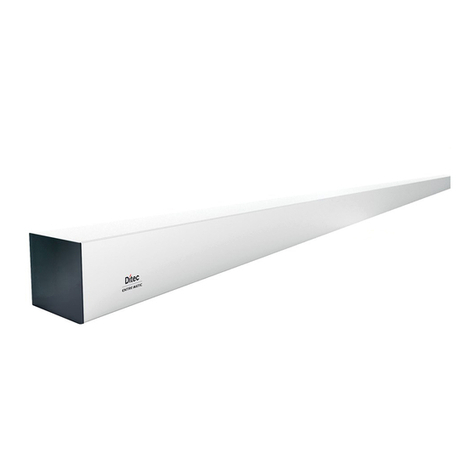
DITEC
DITEC DAS107 User manual
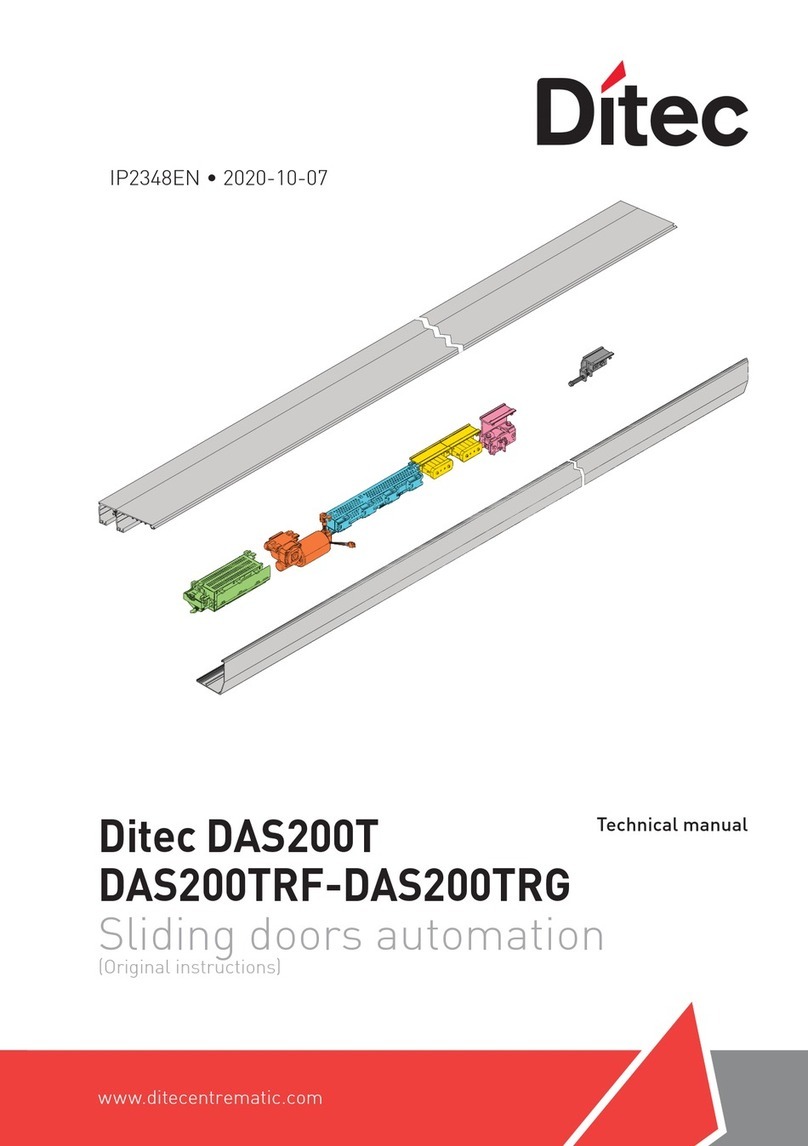
DITEC
DITEC DAS200TRF User manual
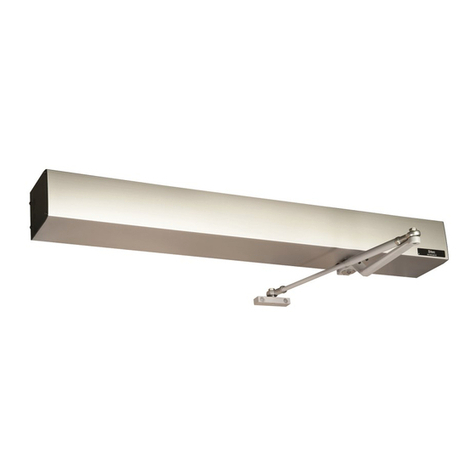
DITEC
DITEC ENTREMATIC HA9 Service manual
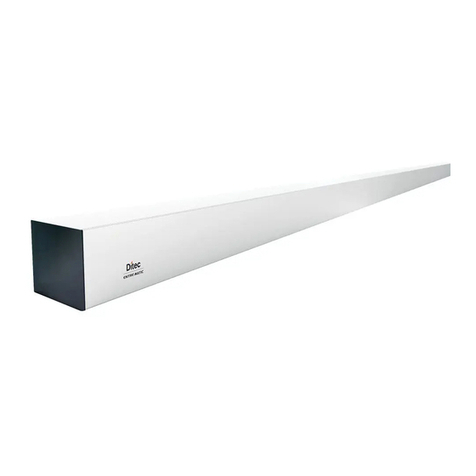
DITEC
DITEC DAS107PLUS User manual
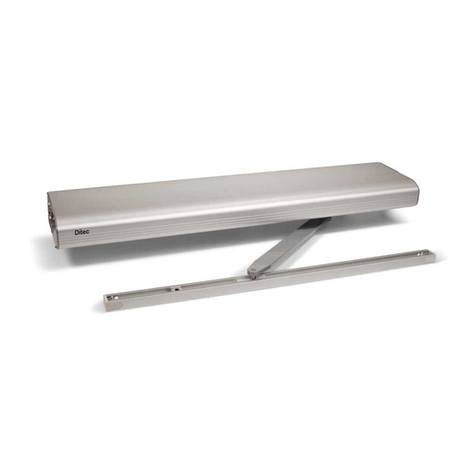
DITEC
DITEC DAB305 User manual
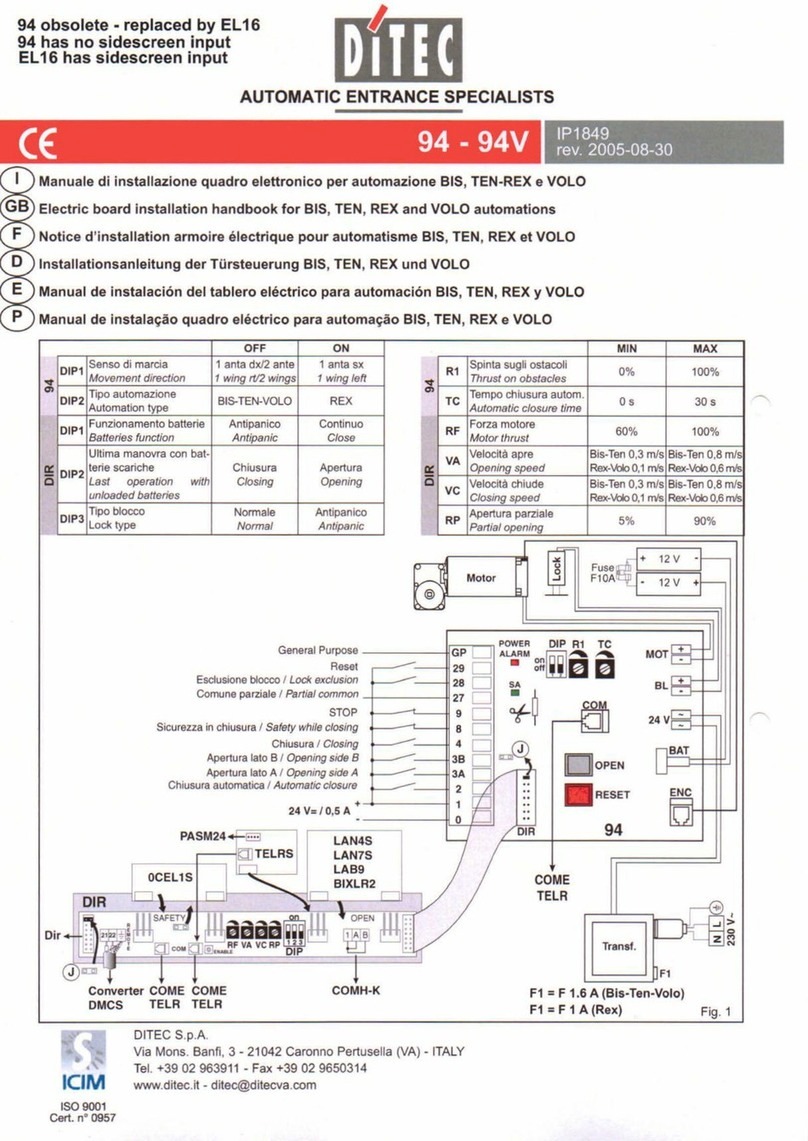
DITEC
DITEC 94 System manual

DITEC
DITEC DOD User manual
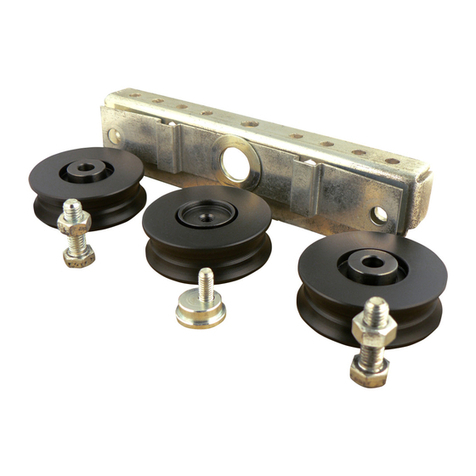
DITEC
DITEC GT Series Manual

DITEC
DITEC COM E User manual

DITEC
DITEC Flash C User guide
Popular Door Opening System manuals by other brands
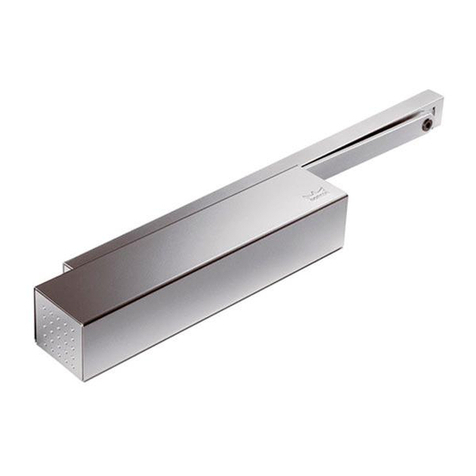
Dorma
Dorma TS93 T installation guide
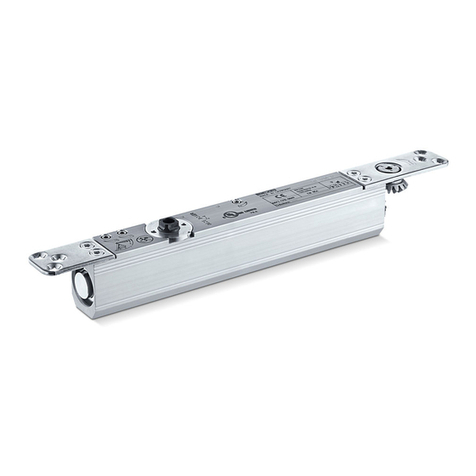
GEZE
GEZE Boxer Series installation instructions
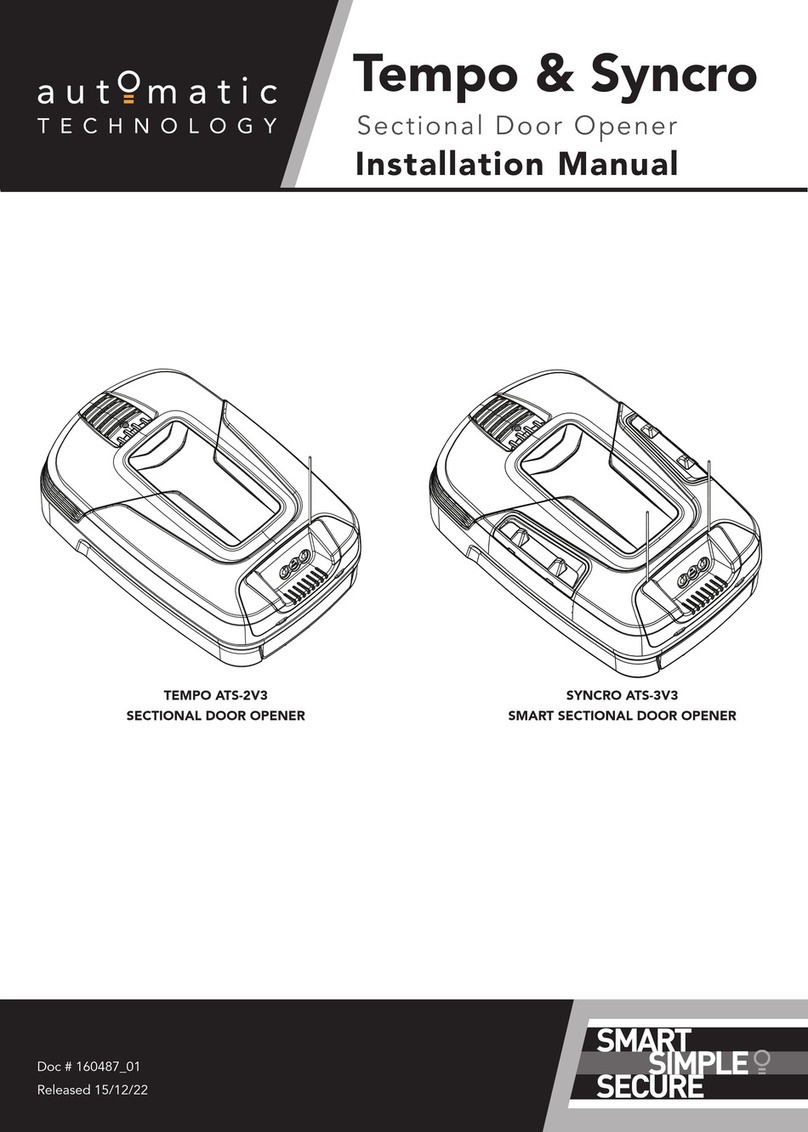
Automatic Technology
Automatic Technology TEMPO ATS-2V3 installation manual
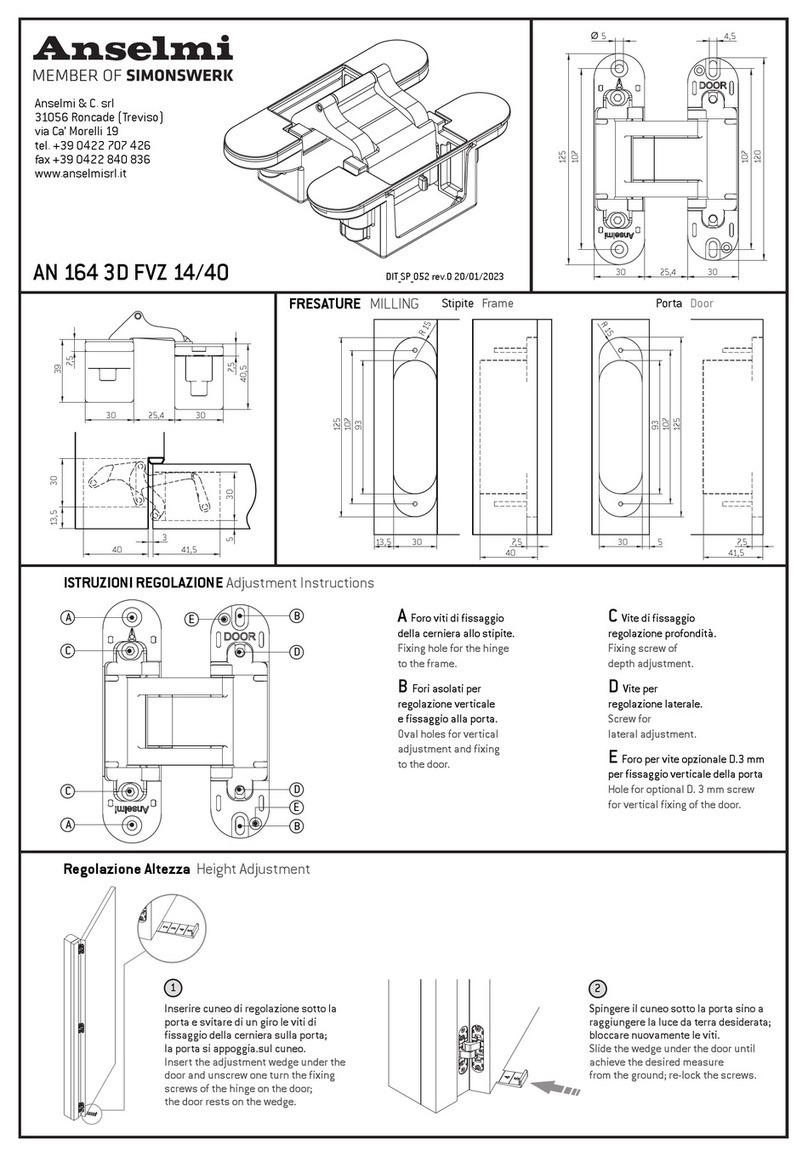
SIMONSWERK
SIMONSWERK Anselmi AN 164 3D FVZ 14/40 quick start guide
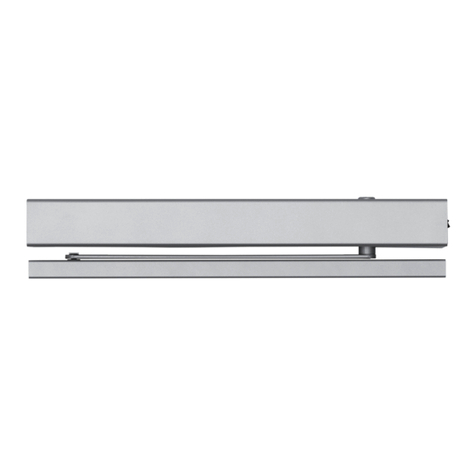
Dormakaba
Dormakaba ED900 owner's manual
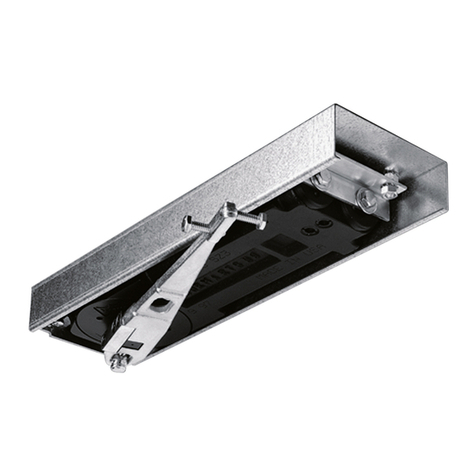
Dormakaba
Dormakaba RTS Series installation instructions
